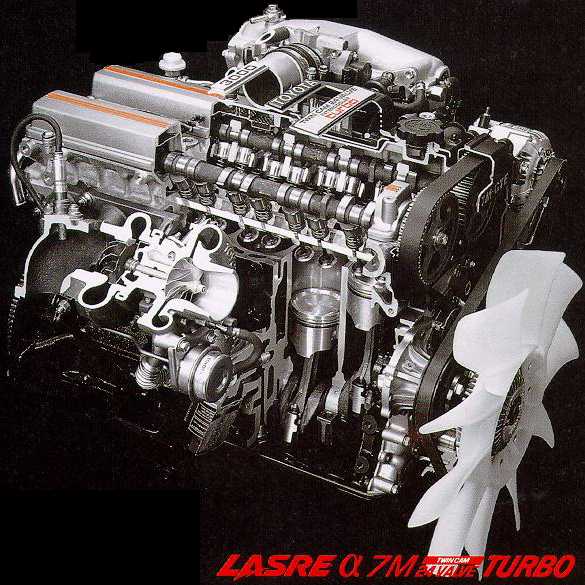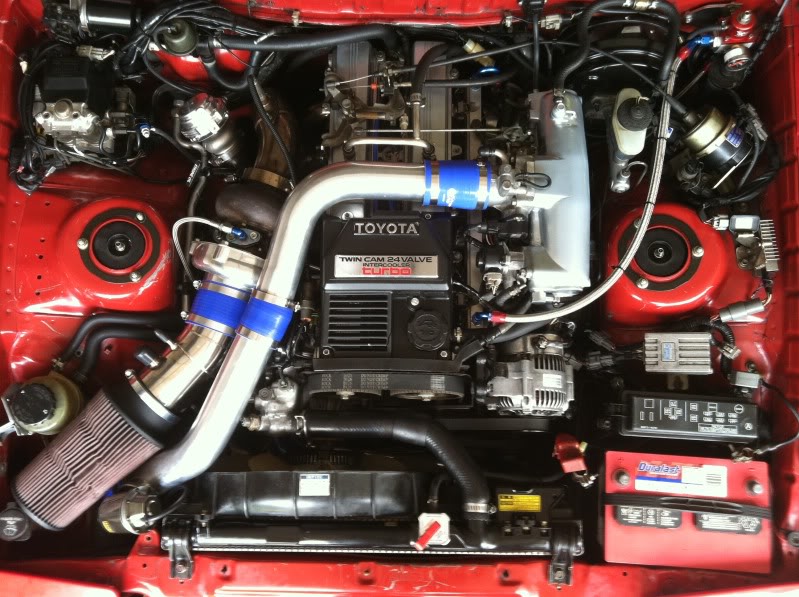Following the Toyota philosophy of continuous development of material and technology, the 7MG had a trouble-free design - with the exception of the cylinder head! Both in the turbo and the non-turbo variant, the seal tended to fatigue at about 80,000 KM. It does not matter if the car was extremely or slightly loaded. The maximum life of a normally driven engine is therefore only 150,000KM!
The basic principle is that this machine will withstand any performance that you will be exposed to as long as you know and adhere to the maintenance requirements (especially head gasket). If you keep a new seal in stock, this engine can develop unforeseen forces.
 The later models already had the Lexus typical oil filled fixtures. The slight increase in horsepower of the last 7MG engines was only due to a better engine management and differences in the exhaust system. Technically, they were identical.
The later models already had the Lexus typical oil filled fixtures. The slight increase in horsepower of the last 7MG engines was only due to a better engine management and differences in the exhaust system. Technically, they were identical.
In competition with other sports cars, the Supra was disadvantaged by its heavy body. Despite some race victories, she has never won an important title with this engine. Thanks to Japanese tuners like HKS, GReddy and Blitz, the road version has long dominated the fight against competitors. In its time and in its class, 7MG was THE engine. As a result, older Celica Supras, RWD Celicas, some pick-ups and even a boat were stocked with these machines.
Tuning the 7MG / 7MGTE:
Block : the engine block is easy, but does not tolerate low oil levels. It is a very robust base element that copes with even extremely high horsepower increases. Since it has a long crankshaft, the search for cracks and fatigue in the rebuild is mandatory. The connecting rods should also be thoroughly tested because they are exposed to high loads. The maximum stroke should therefore not exceed 85.5mm (series = 83mm).
For normal engines, the compression can be increased to a maximum of 12.5 before the cylinder design interferes with the exhaust flow. For turbo engines the compression can be reduced to a minimum of 8.0: 1. The original pistons have not benefited from the later popular Toyotatechnik coating, so that for every major project forged pistons are the only way!
Despite the engine's high speed of rotation, permanently increased pressure above 16psi can cause the head to warp. Reasonable use of boosts over 30psi, however, is not uncommon and quite defensible.
The block should be planned and honed as best as possible (mirror finish), as the head gasket in the surface is depressed. You should therefore make sure that the aluminum cover is on the block when the surface is planned, otherwise the seal will not fit properly. In addition, all fastening screws should be replaced (eg ARP), the hoses should be checked and, if necessary, replaced and a replacement head gasket kept ready.
Cylinder head : The 24 valve head is easy, but should be regularly checked for distortion. The aluminum has a natural tendency to show material weakness at the waterways - so you should use the best antifreeze that you can get to avoid erosion and decomposition of the aluminum. The inlet and outlet channels can be polished, of course, but this is not mandatory and there are better places to create his money performance enhancing.
Special camshafts can exploit the full potential of the 24 valve head, but you should not go above 280 degrees because low cylinder pressure would otherwise give erratic values to the ECU. At the cam pin usually forms a soft coating, which should be removed in any case. The brightly polished cams can then be used without problems.
The valve seals in some engines harden unusually fast, often even before the cylinder head gasket is due. Therefore, you should always replace the valve seals when changing the cylinder head gasket. Just as with the block, the head polishing is up to the "mirror finish" duty! It should then only use a metal head gasket for maximum durability between 2 maintenance intervals.
Injection system : The standard injection system for the NA and Turbo models is sufficient. For far-reaching turbo modifications please read the next section. If the amount of fuel provided is insufficient, the use of 550cc injectors is recommended - in addition, use the fuel pump from the JZA80, which is a direct replacement.
Turbo Upgrade : The serial turbo is capable of boosts up to max. 14psi (1Bar) to produce. Attempts to increase the pressure even further, are relatively meaningless. Sorted by importance: Exhaust system, Intercooler, Boost Controller, Ignition, Fuel Computer, Turbo, VPC, Injectors - these are the right steps for more power. Everything about 14psi can be meaningfully realized only with a machined block and forged pistons.
 The availability of metal head gaskets in various thicknesses and designs is primarily intended to prevent twisting of the head and block and to allow easy adjustment of the compression. There are 3 types of MHGs: Stopper, Bead and Gronmet. The stopper variant is a multi-layer part that is much more durable than the series seal, which consists of only one layer. Bead also has several layers, is slightly more flexible and has a raised edge that helps to seal the pistons optimally. Gronmet has an additional sealing ring (like the series parts) and therefore tolerates the most "maltreatments".
The availability of metal head gaskets in various thicknesses and designs is primarily intended to prevent twisting of the head and block and to allow easy adjustment of the compression. There are 3 types of MHGs: Stopper, Bead and Gronmet. The stopper variant is a multi-layer part that is much more durable than the series seal, which consists of only one layer. Bead also has several layers, is slightly more flexible and has a raised edge that helps to seal the pistons optimally. Gronmet has an additional sealing ring (like the series parts) and therefore tolerates the most "maltreatments".
The most effective turbo upgrade is based on the standard CT26. Some companies such as Turbonetics or Toysport offer a complete overhaul. The latter even has a TwinTurbo upgrade for the 7MGT in the program, which is based on the HKS TwinTurbo set for the old 5MG. In addition to these two variants, the most common measure is the installation of a Garett T04 loader, which by the way is also included in the HKS SingleTurbo set.
Ignition system : The simplest and most sensible upgrade for both NA and Turbo is HKS TwinPower. All other systems can be forgotten. It is also advisable to replace the ignition cables with MSD or NGK.
A few sinnvole set-ups
for serial production : the 7MGE / TE is a common engine that good workshops can easily service. The processing of parts should only be entrusted to known companies, as the tolerance values are very important and specific. Backyard workshops should by no means carry out this work. Exchanging the exhaust system can bring more power immediately, as the standard equipment tapers on the axles, while sports systems maintain the full diameter.
for modified performance : The non-turbo model should be able to achieve respectable results with a sharper camshaft, machined head and a good exhaust system, but never reach the performance of a turbo. For these models, please read the section on Turbo Upgrades again.
for racing : use the old Celica Supra body or remove everything that is missing in the interior, because not the engine, but the high weight prevent a real chance in the race competition.